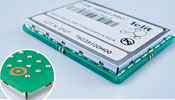

Telit Wireless Solutions recently unveiled the newest addition to its GE product family, the GE863-PRO3 wireless communication module. Equipped with two powerful microprocessors, this quad-band module is suited for a wide range of applications requiring high processing power, such as point-of-sale terminals, fleet management systems and multimode automated meter reading (AMR) applications.
The GE863-PRO3 GSM/GPRS module is the first in the Telit PRO3 professional dual-processor product line. Due to an integrated ARM9 processor, software applications can take full control of the CPU, while the GPRS-based band processor handles time-critical communication tasks. The module can be programmed in both Python and C++ programming languages.
With its integrated firmware-over-the-air (FOTA) solution, the GE863-PRO3 offers the benefits of remote software updates. This function enables system integrators and developers to ensure that the firmware of the product can be upgraded with the latest enhancements and features. Furthermore, the advantage of FOTA can be made available for the customer application software. This allows total remote device management, thereby improving the functionalities of the application devices while reducing the cost of the product.
The powerful ATMEL ARM9 processor enables control of realtime applications requiring up to 200 MIPS. With the same form factor as Telit's compact GE863 module, tried-and-tested ball grid array (BGA) mounting technology, and an integrated memory for software applications, the GE863-PRO3 provides significant benefits for the development and production of complex solutions. The module also features integrated memory (Flash and RAM) and independent energy management for both CPUs, eliminating the need for additional external memory in the application design.
With its external dimensions of just 41 x 31 x 3,6 mm, the GE863-PRO3 is particularly suitable for applications where a compact form is important. As with all other Telit products, this module is to be fully certified for use on all US carriers and, given that it shares cellular radio and stack structures with other members of the popular GE863 product family, customers can also avoid additional costs and time spent on complex re-testing procedures, benefiting from a faster time to market.
In addition to over-the-air installation of firmware upgrades, the module also features the following interfaces: SPI, IIC, SD/MMC and USB, allowing reliable connectivity with peripheral hardware or software such as a camera, keyboard, display, WiFi, Bluetooth or ZigBee.
For more information contact Andrew Hutton, RF Design, +27 (0)11 695 2200.
| Tel: | +27 21 555 8400 |
| Email: | [email protected] |
| www: | www.rfdesign.co.za |
| Articles: | More information and articles about RF Design |

© Technews Publishing (Pty) Ltd | All Rights Reserved